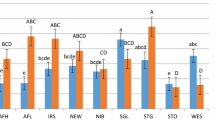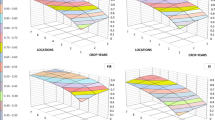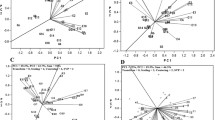Summary
Selection of test locations, representative of conditions and practices of an area can be a challenging process in a breeding program. Data from two groups of sugarcane (trispecies hybrids of Saccharum sp.) cultivar experiments in Florida were analyzed to determine if relative cultivar response at any two of six current locations was sufficiently similar so that at least one location could be replaced by a location with a different environment. The parameter analyzed was metric tons per ha of sugar (THS). To determine similarity between location pairs for all cultivars within each group of cultivars, an unbiased stability-variance parameter (\(\hat \sigma _{ i}^2\)) developed by Shukla was used. After \(\hat \sigma _{ i}^2\)identified similar location pairs, single degree of freedom interactions were calculated for important cultivars to determine which of the location pairs identified by \(\hat \sigma _{ i}^2\)contained the two most similar locations. Use of the above procedure can assist in making optimum location assignments in a breeding program.
Similar content being viewed by others

References
Arceneaux G (1935) A simplified method of making theoretical sugar yield calculations. In accordance with the Winter-Carp-Geerligs formula. Int Sugar J 37:264–265
Brown KD, Sorrells ME, Coffman WR (1983) A method for classification and evaluation of testing environments. Crop Sci 23:889–893
Busey P (1983) Management of crop breeding. In: Wood DR (ed) Crop breeding. Am Soc Agron, Madison Wis
Glaz B, Dean JL, Kang MS, Miller JD, Sosa O Jr, Tai PYP (1981) Sugarcane variety tests in Florida, 1980/81 harvest season. USDA-ARS, New Orleans, 18 pp
Glaz B, Dean JL, Kang MS, Miller JD, Tai PYP, Sosa O Jr (1982) Sugarcane variety tests in Florida, 1981/82 harvest season. USDA-ARS, New Orleans, 21 pp
Glaz B, Dean JL, Miller JD, Tai PYP (1980) Sugarcane variety tests in Florida, 1979/80 harvest season. USDA-ARS, New Orleans, 17 pp
Kang MS, Miller JD (1984) Genotype x environment interactions for cane and sugar yield and their implications in sugarcane breeding. Crop Sci 24:435–440
Rice ER (1979) Sugarcane variety tests in Florida, 1978/79 harvest season. US Sci Educ Admin, New Orleans, 16 pp
Shukla GK (1972) Some statistical aspects of partitioning genotype-environmental components of variability. Heredity 29:237–245
Snyder GH, Burdine HW, Crockett JR, Gascho GJ, Harrison DS, Kidder G, Mishoe JW, Myhre DL, Pate FM, Shih SF (1978) Water table management for organic soil conservation and crop production in the Florida Everglades. Univ Fl Inst Food Agric Sci Tech Bull 801, 22 pp
Steel RGD, Torrie JH (1960) Principles and procedures of statistics. McGraw-Hill, New York
Author information
Authors and Affiliations
Additional information
Communicated by G. S. Khush
Cooperative investigation of the U.S. Sugarcane Field Stn., Canal Point, FL; and University of Florida, Everglades. Res. and Educ. Ctr., Belle Glade, FL, USA
Rights and permissions
About this article
Cite this article
Glaz, B., Miller, J.D. & Kang, M.S. Evaluation of cultivar-testing locations in sugarcane. Theoret. Appl. Genetics 71, 22–25 (1985). https://doi.org/10.1007/BF00278248
Received:
Accepted:
Issue Date:
DOI: https://doi.org/10.1007/BF00278248



